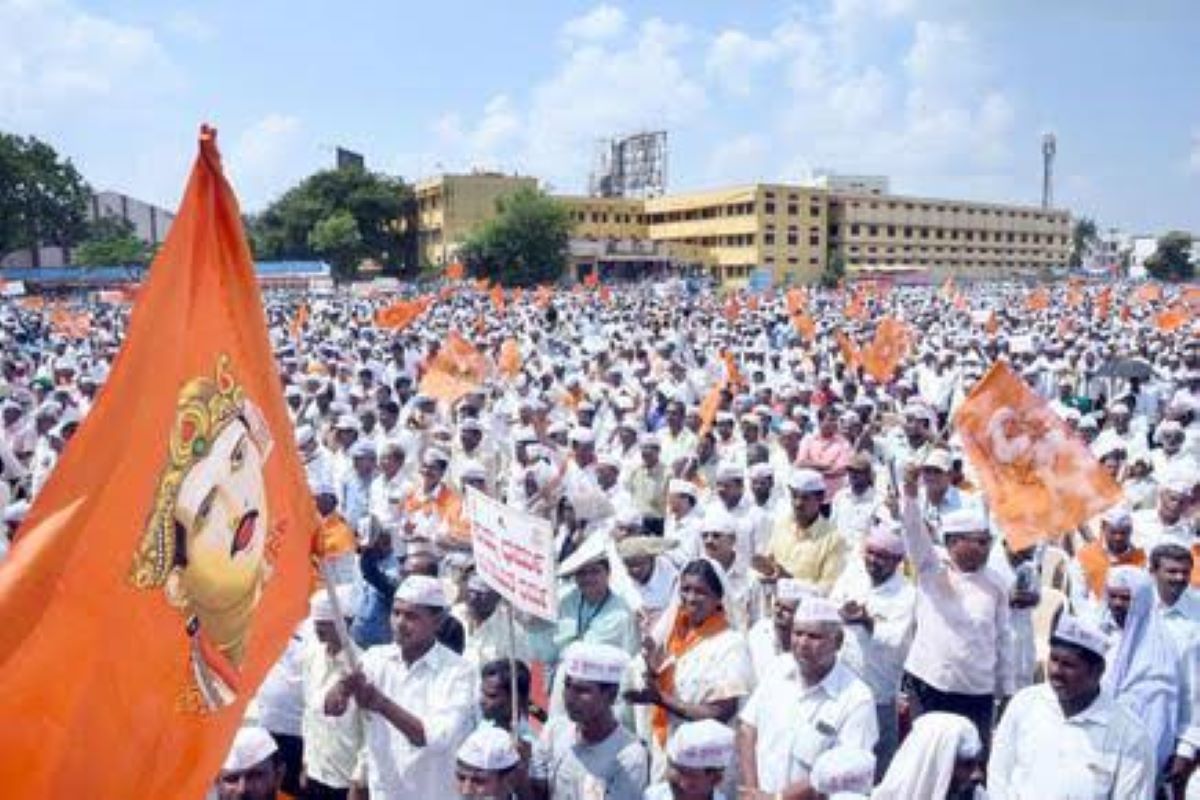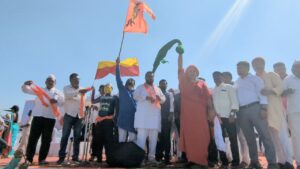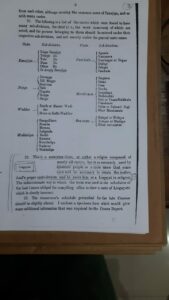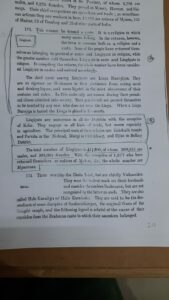Were Lingayats ever seen as a separate religion? The then Siddaramaiah government's decision to recommend to the Centre to give them the status is believed to have hurt the party in the 2018 elections. However, Lingayat leaders demanding such a status dispute the claim and say prominent Vokkaliga leaders played a major role in the defeat of the Congress.

A Lingayat rally held in Belagavi in 2018
With less than five months left for the 2023 polls to the Karnataka Legislative Assembly, the ruling BJP government is caught between the devil and the deep sea, with majority communities demanding caste reservation, and a section of the Lingayats demanding separate religion status.
With elections drawing nearer, the BJP government cannot do anything except extend promises. The demand for reservations in a way has derailed the party’s poll strategy.
Hindu nationalism, generally defined as an ethnoreligious movement and primarily a reaction to the Mandal movement, has been yielding dividends for the BJP since the 90s. This has become its poll plank in the last three decades.
However, as far as the coming polls to the Karnataka Assembly are concerned, it appears caste is emerging as an alternative to the Hindutva narrative.
With the passing of each day, the BJP government in Karnataka is feeling the heat of caste reservation, with Lingayats, Vokkaligas, Edigas, and Kurubas stepping up the demand for an increase in their reservation percentage or inclusion in other categories.
Since Independence, the Lingayats and Vokkaligas have been controlling the levers of power, claiming to be the major communities in Karnataka.
These powerful castes have always accounted for 50 percent of the Lok Sabha and Vidhana Sabha seats in the state, irrespective of the party in power. These two dominant castes have made reservations a poll agenda.
Interestingly, the leaked reports of the Socio-Economic Caste Census in Karnataka conducted by the previous Congress government point to the fact that the Lingayat community forms 14 percent of the total population. The Vokkaliga community’s share is 11 percent.
These two communities occupy the third and fourth place in the total proportion in the state, while the Scheduled Castes and Muslim communities occupy the first and second slots with 19.5 percent and 16 percent respectively.
While Vokkaligas are demanding a hike in their reservation from 4 percent to 12 percent, Panchamasalis — a major sect of the Lingayat community — have been demanding that the government include them in the 2A reservation category.
The Kuruba community (to which former chief minister Siddaramaiah belongs) wants to move into the ST category, even as the Ediga community wants to move to Category A.
Both the Vokkaliga and Lingayat communities are extremely influential in Karnataka politics and will be the deciding factor for the BJP.
Political analysts see the developments as a case of competitive pressure politics on the eve of elections and describe the pressure being mounted by both Lingayat and Vokkaliga communities as a strategy to assert their presence and lobby to claim reservation quotas for their respective caste groups.

Kudalasangama Panchamasali Peetha pontiff Basava Jaya Mruthyunjaya Swami opposes the new 2D category announced for the sect (South First)
Panchamasali Lingayats, a sub-sect of the dominant Veerashaiva-Lingayat community, who are considered to be the BJP’s core voter base, are demanding inclusion in Category 2A (15%) of the Other Backward Castes (OBC) reservation matrix. Presently, they are included under 3B (5%).
In late December, the BJP government in Karnataka, in order to satisfy the demands of the dominant communities, decided to create two new reservation categories — 2C for the Vokkaligas and 2D for Panchamasali Lingayats.
A faction of Panchamasalis has now opposed the move and reiterated their demand for inclusion in Category 2A.
While the BJP government in the state is struggling to wriggle out of this caste conundrum, Lingayats, deemed to be a ‘monolithic’ community, are also divided over the issue of separate religion status.
These differences, which were there even during the previous 2018 polls to the Karnataka Assembly, have widened now with a major section of the Lingayat community led by the Jagatika Lingayat Mahasabha (JLM) distancing itself from a convention organised by the Akhila Bharatha Veerashaiva-Lingayat Mahasabha (ABVLM). The JLM has resolved to hold a parallel convention.
It is important to note that the JLM spearheaded a movement in 2018 seeking a minority religion tag for Lingayats. It has decided to revive plans to press for its ‘years-long’ demand on its own and decided to maintain a distance from the programme planned by the ABVLM.
Following this development, the convention organised by the ABVLM from 24 to 26 December has been postponed to February.
Organisers attributed the postponement to the recent Legislature session at Belagavi. At the same time, the JLM has announced that its first convention will be held at Basavakalyan of Bidar district at the end of January.
The plan is to make the programme a massive show of strength of the Lingayat community and to send a strong message to both the Central and state governments that their demand for a separate religion tag cannot be ignored.
Responding to demands for a separate religion status, the Siddaramaiah-led Congress government had sent a recommendation in its favour to the Union government, “on which the Centre has been blissfully sleeping from the past four years”, says JLM leaders.
This move of the Siddaramaiah government is still being seen as a major reason for the Congress not returning to power in Karnataka. The opposition BJP then accused Siddaramaiah of dividing the caste and held him responsible for the division of the monolithic Lingayat community.
Though both the ABVLM and JLM are demanding a separate religion tag, there is a major difference.
The ABVLM is demanding a separate religion status for the entire community, including the Veerashaiva sub-sect. But the JLM is not ready to consider Veerashaivas as a sub-sect of the Lingayat ‘religion’.
According to SM Jamdar, JLM’s secretary general, Veerashaiva is a part of the Vedic religion since it is based on Shaivite philosophy and hence it is ineligible to be part of the Lingayat religion founded by Basaveshwara, the 12th-century social reformer and saint.
“They are seeking reservation and a separate religion tag. But the JLM is pressing for separate religion status, which has been pending with the Centre for the past four years,” Jamdar argues.
To achieve its goal of getting a separate religion tag, the JLM is even willing to seek legal recourse by moving the Karnataka High Court.
“We will not be a part of the ABVLM because they do not support our concept of separate religion status. We have decided to go our way to get justice for the Lingayat community, which is waiting to get the much-needed separate religion tag status,” says GB Patil, senior leader and general secretary of the JLM.
“The JLM is seeking a separate religion tag for the Lingayat community since it was born out of rebellion against Vedic practices. As Veerashaivas are practising Vedic tradition, they should remain in the Hindu religion. We may consider their inclusion in our movement if they become a follower of Basavanna and follow his ideals, relinquishing their Shaivite practices,” he adds.
But the ABVLM is not ready to accept the conditions being laid by the JLM.
“Seeking reservation under the Central List of OBCs for the community is our goal. We appeal to the Centre and state government to grant it. In the coming polls, the ABVLM will support only those who promise to deliver our demand,” says BS Sachidananda Murthy, vice-president of ABVLM.
The JLM relaunching its movement seeking separate religion status with only a few months left for polls to the Karnataka Assembly is being compared to the movement launched by the outfit in 2018. Political parties, especially the BJP, fear its impact on the political scenario of Karnataka.
On 19 July 2017, the Jagatika Lingayat Mahasabha (JLM) organised a massive rally in Bidar demanding official recognition as an independent religion with minority status.
Though there is nothing new in their demand — which has been in the air since the first half of the 20th century — the mobilisation of over a lakh people of a dominant community was certainly intended to send a signal.
Within weeks, similar demonstrations were held in various parts of north Karnataka where the Lingayats are dominant.
A youth wing — Rashtriya Basava Sene — headed by Vinay Kulkarni, the minister for mines and geology in the Congress government, was formed to take the movement forward.
MB Patil, minister for water resources in the then government, was at the forefront of the movement. It gained momentum with four ministers — Basavaraja Raya Reddy, Sharan Prakash Patil, Eshwar Khandre, and SS Mallikarjun — who belong to the Lingayat community joining hands.
The JLM, which led the movement, cautioned the Centre that it would launch a massive agitation in seven states, including Karnataka, Maharashtra, Telangana, Tamil Nadu, Kerala, Madhya Pradesh, and Andhra Pradesh if its demand for separate religion status for Lingayats was not met.
The outfit set a 30 December 2017 deadline for the state government to recommend to the Centre to make Lingayat a separate religion, besides according minority religion status.
With eyes on the Assembly polls and out of fear of losing the support of the Lingayats, the Siddaramaiah-led Karnataka government decided to grant separate religion status to the community based on the recommendation of Justice Nagamohan Das Committee report. This was despite threats from Veerashaiva Lingayat seers against recommending minority status for Lingayats alone.

Excerpt from the 1871 Census that shows Lingayat was regarded as a separate religion in it (Supplied)
An influential section within the community has long been arguing that Lingayats are followers of a religion distinct from and opposed to Hinduism.
Proponents of this argument argued that the Lingayat faith was founded in the 12th century as a rebellion against Vedic and Brahminical Hinduism and deserves recognition along the lines of Buddhism, Jainism, and Sikhism.
MM Kalburgi, a renowned scholar who was shot dead by Hindu fundamentalists in 2015, was a prominent votary for the demand for separate religion status for Lingayats.
SM Jamdar of the JLM provides documentary evidence to show that Lingayatism was recognised as a separate religion in the 1871 Census and asserts this was the case until the 1881 Census of Mysore State.
This is evident in the Census report of Mysore State prepared by AWC Lindsay. Lindsay recorded that “in compiling the returns the word Lingayat is used in the enumerators’ forms both as a caste and as a religion and sometimes as a religion only. Properly speaking there is no Lingayat caste, but many castes are Lingayat in religion. The word however occurred so often as a caste that it was impossible to avoid including a caste under this appellation”.

Excerpt from the 1871 Census that shows Lingayat was regarded as a separate religion in it (Supplied)
Surprisingly in the 1881 Census of Mysore, for reasons best known to the then Diwan of Mysore Sri C Rangacharlu, who personally supervised the Census operation till his death in January 1883, Lingayats were merged with Hindus and its sub-castes were categorised into Brahmin, Kshatriya, Vaishya, and Shudra groups.
“Deliberately Lingayat was left out and virtually dissolved into Hinduism by the Diwan,” accuses Jamdar.
While proponents of Lingayatism were strongly demanding a separate religion status, political observers and political parties, especially the BJP, suspected that the movement was a part of the then ruling Congress party’s strategy in election year.
The BJP leaders, including present Home Minister Amit Shah, accused the Congress of dividing society in the name of religion.
There was a consistent campaign by powerful Veerashaiva leaders of the BJP. And the movement declaring support to the Congress in the last hour, for according minority religion tag and forwarding the same to Centre, boomeranged. The Congress failed in achieving the expected numbers to form the government.
However, Jamdar disputes the understanding that Congress lost in the polls just because of raking up the Lingayat religion issue.
Other leaders of the JLM accuse the anti-Lingayat lobby and say prominent Vokkaliga leaders played a major role in humbling the Congress in the polls and made use of the Lingayat religion status issue.
Will rejuvenating the movement again at the time of polls to the Karnataka Assembly lead to a similar impact on the Congress, which is raring to capture power now?
“Relaunching the movement has nothing to do with the coming polls. The JLM never supported the Congress and it will be sympathetic to any party, including the BJP, that strives to get separate religion status to Lingayats and pressurise the Union government on the issue,” clarifies Jamdar.
“The JLM will place its demand in front of all the political parties, as we don’t know who will come to power in the state. To make it very clear, it is not a poll demand of the JLM. Failure of political parties of Karnataka in fulfilling our demand will force us to make the movement stronger not only in Karnataka but in other parts of the country, at least in the six states,” he cautions.
It remains to be seen how chief minister Basavaraj Bommai and the BJP’s state president Nalin Kumar Kateel pull the fine balancing act as the caste-politics temperature is rising and demands from various communities escalate by the day.
(Muralidhara Khajane is a senior journalist, writer, and film critic. He is the author of ‘Random Reflections: A Kaleidoscopic Musings on Kannada Cinema’. These are the personal views of the author)

Apr 25, 2024

Apr 25, 2024

Apr 25, 2024

Apr 25, 2024

Apr 24, 2024

Apr 24, 2024